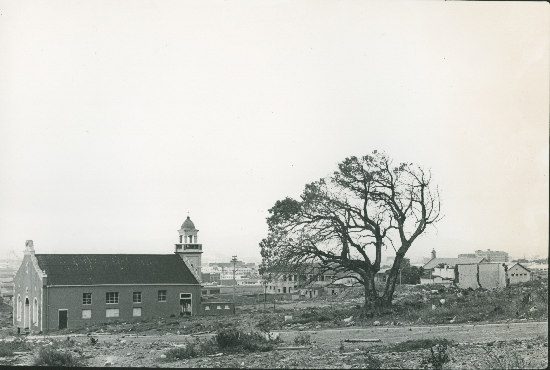|
11 February 2010
District Six: recalling the forced removals
On February 11, 1966, the apartheid government declared Cape Town's District Six a whites-only area under the Group Areas Act of 1950. From 1968, over 60 000 of its inhabitants were forcibly removed to the Cape Flats, over twenty five kilometers away. Except for the local houses of worship, the buildings were systematically bulldozed throughout the 1970s, and by 1982, almost all evidence of the district had been destroyed. Originally named the Sixth Municipal District of Cape Town in 1867, the neighbourhood was home to almost ten per cent of the city's population. Its unique culture was a composite of the dynamic and diverse population of Malay, Eastern European, Indian and African immigrants, ex-slaves, artists, musicians and activists. District Six was famed for its proximity to the City Centre, as well as its view of the picturesque Table Mountain and harbour. District Six had experienced a long history of removals, with black residents forcibly removed as early as 1901. This was intensified in the early 1960s, when residents were perfunctorily given notice and informed of their new homes. By the mid 1960s the apartheid government regarded the district as both physically and morally tainted by miscegenation, wholly unfit for rehabilitation. Over the next two decades, they systematically razed it to the ground.

District Six after the removals. Photographer: Jimi Matthews, undated
The District Six Museum
"...there is nothing that can be hidden from the mind. Nothing that memory cannot reach or touch or call back." - Don Mattera, 1987
The destruction of District Six wrought a permanent blight on the city of Cape Town. In 1989, the District Six Museum Foundation was founded. This community organisation sought to protect the area where District Six had once stood, in spite of its transformation into an empty wasteland. The District Six Museum was established in 1994. It provided both a tangible space for bringing life to a community lost to the vagaries of apartheid, as well as providing a platform for social justice. Through educational programmes, collections and exhibitions, the District Six Museum provides a voice for the stories of those displaced and dispossessed by apartheid-era forced removals. It is also committed to the reconstruction of the community by advancing a culture of multi-culturalism, non-racialism and open debate. By 2003, construction had begun as a part of the ANC government's commitment to redress the claims of former District Six residents. On February 11, 2004, Nelson Mandela handed the keys to the new homes built for two octogenarian ex-residents whose lives had been adversely affected by forced removals. Madiba's symbolic gesture evoked the memory of his own release from prison exactly fourteen years earlier, highlighting the significance of February 11th in the annals of South African history.
District Six and Forced Removals in SAHA Collections
SAHA has a variety of posters, photographs, documents and ephemera related to District Six and forced removals.
Please refer to:
Original SAHA Collection (AL2457)
The SAHA Poster Collection (AL2446)
-
AL2446_247 Poster on the Crossroads removals
-
AL2446_424 Poster by the Christian community on forced removals
-
AL2446_1129 Poster by the UDF calling for a rally to discuss Crossroads
-
AL2446_1929 Poster by UCT Centre for African Studies on forced removals in South Africa
SAHA Ephemera Collection (AL2540)
T-shirts:
-
AL2540_A261T-shirt in commemoration of the 10th anniversary of forced removals (1987-1998)
-
AL2540_A290 T-shirt in protest of forced removals
-
AL2540_A300 T-shirt in protest to stop Lawaaikamp removals
Stickers:
SAHA Original Photograph Collection (AL2547)
-
AL2547_20.1.1 - AL2547_20.1.20 Photos of forced removals from Batlokwa, Magopa, Oukasie, Crossroads and others in the 1980s.
The Gille de Vlieg Photo Collection (AL3274)
-
AL2374_A4 Priests at night vigil, including Bishop Tutu, prior to the announced removal, Mogopa, North West, November 11, 1983
-
AL2374_B5 Rural lifestyle scenes, including forced removals, Driefontein, Mpumalanga, May 10, 1984
-
AL2374_C28 Barolong protest about forced removals, Rooigrond, North West, July 14, 1985
-
AL2374_D1 Vigilante attack about forced removals, Moutse, Mpumalanga, January 4, 1986
-
AL2374_D5 Removal from Kwarrielaagte in Moutse to Kwaggafontein, KwaNdebele, Mpumalanga, February 7, 1986
-
AL2374_D12 Oukasie protest meeting and lifestyle, Brits, North West, April 6, 1986
-
AL2374_D23 Apartheid land removals, Rooigrond, North West, August 24, 1986
-
AL2374_D34 Rural lifestyle, Mathopiestad, North West, November 23, 1986
-
AL2374_E5 Apartheid land removals, Makhado (Louis Trichardt), Limpopo, May 12, 1987
-
AL2374_E9 Apartheid land removals, Eikenhof, Gauteng, November 5, 1987
-
AL2374_E12 Apartheid land removals, lifestyle, Oukasie, Brits, North West, November 18, 1987
-
AL2374_F36 Apartheid land removals, Cornfields, Kwazulu-Natal, November 22, 1988
|
|








